Best smartphone: The latest launches from Apple, Huawei and Sony
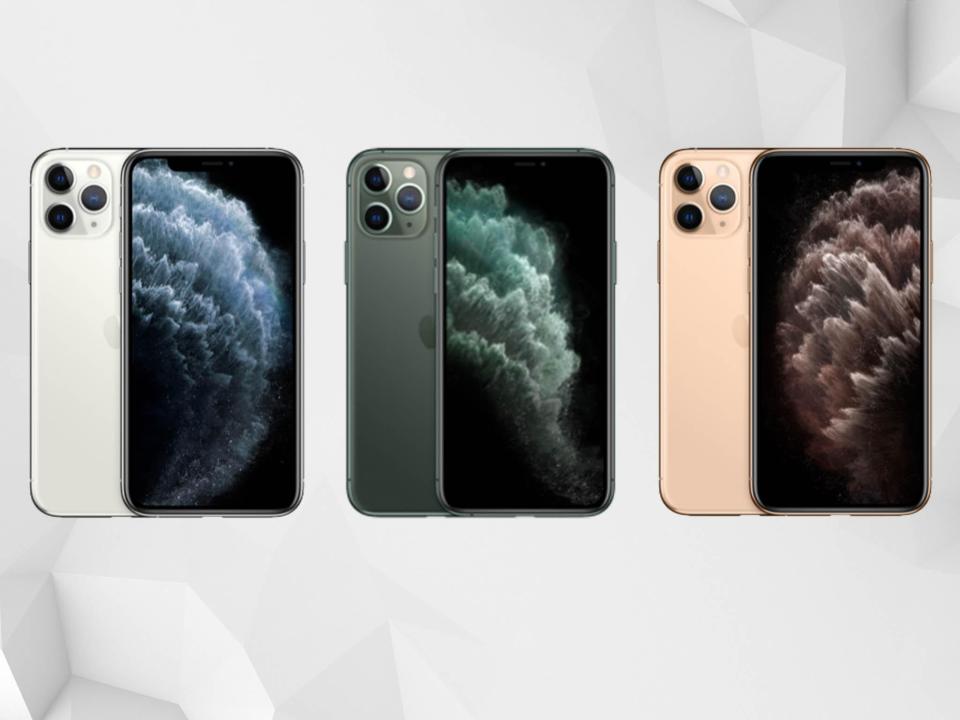
What do you want from a smartphone? Everything, probably. After all, it’s your camera, satnav, email, social media hub, games machine, digital wallet, video viewer and portal to the internet. Oh, and it makes phone calls. Priorities today are different from even a few years ago: big screens are popular – edge-to-edge screens especially. But the desire for good battery life remains unchanged.
There are two operating systems to choose from: iOS – which runs only on Apple devices like the iPhone or iPad – and Android, from Google. Android is the system which every manufacturer other than Apple has now adopted (even companies like Nokia and BlackBerry who previously went their own way).
The advantages of iOS include the smooth, seamless way it integrates with Apple products such as your iPad, Mac and the smart HomePod speaker. Android users will also find switching from one Android brand to another, say from Huawei to Sony, a painless process, as Google insists on a degree of uniformity for companies using the platform.
The move to screens which cover the whole of the front of a phone, or almost, has led to something called “the notch”, a cutout at the top of the display where the camera sits. In the case of the iPhone XS, XS Max and forthcoming XR phones, that’s where the TrueDepth camera sits, which delivers high-quality facial recognition that obviates the need for a fingerprint sensor.
Other phones have this notch, and sometimes facial recognition – but Apple’s system is the only one that’s good enough for you to remove the fingerprint sensor, and it works safely with the digital wallet, Apple Pay.
Other phones have fingerprint sensors too, on the back in every case here, apart from the BlackBerry.
Many phones now have twin rear cameras (and one even has three). Often these are lenses with different focal lengths to help overcome the feature that phone cameras lack: optical zoom. If one camera has twice the focal length of the other, you effectively have a double zoom. Twin lenses also mean you can shoot both cameras at the same time and software can work out what’s what, so it can create a delightful bokeh effect where the subject is in sharp focus and the background artistically blurred.
Note that most flagship phones now lack a traditional headphone jack, so you’ll need to use the supplied headphones, an adaptor with your favourite headphones, or wireless cans. Most phones, though not the latest iPhones, include an adaptor – in Apple’s case you can buy it separately for £9.
You can trust our independent reviews. We may earn commission from some of the retailers, but we never allow this to influence selections, which are formed from real-world testing and expert advice. This revenue helps to fund journalism across The Independent.
Apple iPhone 11 Pro: From £999, Apple
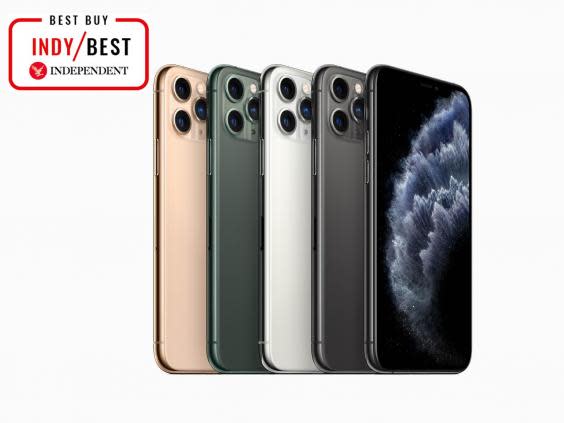
Screen size and resolution: 5.8in, 1125 x 2436 pixels, 458 pixels per inch
Screen technology: OLED
Storage capacity: 64/256/512GB
Expandable storage? No
Camera (rear): 12MP wide, 12MP telephoto, 12MP ultra-wide
Camera (front): 12MP
Dimensions: 144 x 71.4 x 8.1mm
Weight: 188g
Headphone jack? No
The latest top-flight iPhone is the best yet. It has three rear cameras which are capable of great versatility and solid, realistic effects including a deft portrait mode where the subject is in pin-sharp focus and the background delicately blurred. There’s also a night mode which launches automatically in low light to boost light in a realistic and attractive way. The third camera is an ultra-wide lens which lets you take in much more of the location easily.
Just as importantly, the latest iPhones have significantly improved battery life so that the phone will really last all day with no issue, which is great for peace of mind. Video capture is also exceptionally good, with super-high resolution 4K video and the facility to shoot video while you’re in still picture mode by holding the shutter button. The front-facing camera is also improved, now a 12MP camera like the three on the back.
The new processor is blazingly fast, Face ID, Apple’s superb and secure face-recognition system is improved to work at more angles, and the software now has a dark mode (available to all iPhones running iOS 13). It comes in two sizes. The iPhone 11 Pro has a 5.8in display and the iPhone 11 Pro Max a 6.5in screen. The larger model costs £100 more.
Samsung Galaxy S10+: £899, Samsung
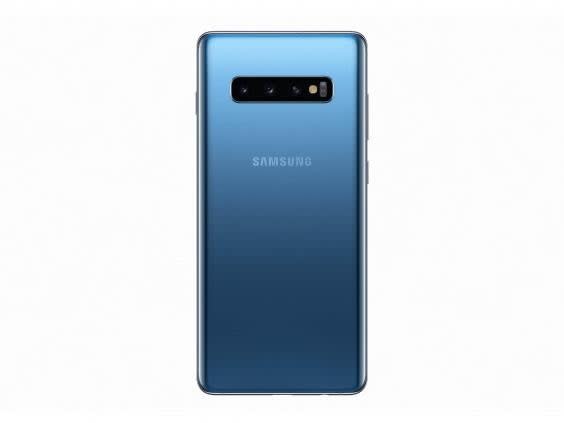
Screen size and resolution: 6.4in, 1440 x 3040 pixels, 522ppi
Screen technology: OLED
Storage capacity: 128GB/512GB/1TB
Expandable storage? Yes
Camera (rear): 12MP wide-angle, 12MP telephoto, 16MP ultra-wide
Camera (front): 10MP plus 8MP
Dimensions: 157.6 x 74.1 x 7.8mm
Weight: 175g
Headphone jack? Yes
The latest in the Galaxy S series from Samsung comes in three versions: S10e, S10 and this model, the S10+, while a Galaxy S10 5G will follow later in the year. The S10+ has a dazzlingly attractive, high-resolution screen which is bright and vivid. It has a very cool fingerprint sensor which is buried in the display itself. Press, and a ripple effect appears and the phone unlocks. It also has two-way wireless charging. This means that not only can you charge the phone by placing it on a wireless charging pad, you can turn the phone into a charger. When you launch the Wireless PowerShare app, it will charge another compatible phone by holding the two together and it doesn’t need to be another Samsung phone, just any wireless chargeable handset. Until now, the Huawei Mate 20 Pro was the only phone with this feature, but the Huawei P30 Pro also has this feature. Samsung has its own virtual personal assistant, called Bixby. It’s no match for Siri, but it’s getting better (though she sometimes sounds very stroppy, which isn’t always what you want).
The three rear cameras are very fast and work well even in low light. The ultra-wide lens is great for landscapes. Battery life is strong and performance is fast. Instead of a notch out of the display, the front-facing cameras (there are two of them) peep out from a small cutout in the screen. This is by far the smartest-looking phone yet from Samsung.
Apple iPhone 11: From £729, Apple

Screen size and resolution: 6.1in, 1125 x 2436 pixels, 458 pixels per inch
Screen technology: LCD
Storage capacity: 64/128/256GB
Expandable storage? No
Camera (rear): 12MP wide, 12MP telephoto
Camera (front): 12MP
Dimensions: 150.9 x 75.7 x 8.3mm
Weight: 194g
Headphone jack? No
The latest iPhone comes in six different colours, including two brand-new shades, purple (really more of a lavender, but very nice) and green. It has two cameras, identical to the wide and ultra-wide lenses on the iPhone 11 Pro, plus the same 12MP front-facing camera. It also shares the same super-fast processor as the Pro models, so this is a powerful phone. It also has great battery life and many other features including face ID.
The display here is LCD, not the more expensive OLED on the other new iPhones, but Apple has managed to create an LCD with very narrow bezels, which most rivals have failed to do.
Like the Pro, it has access to Apple’s millions of apps, sublime operating system and reputation of outstanding security. Battery life, already good on the iPhone XR, which it follows, is even better here. This iPhone, unusually, is at a lower price than its immediate predecessor. That phone, the iPhone XR, also remains on sale and has dropped in price to £699.
Huawei P30 Pro: £899, Carphone Warehouse
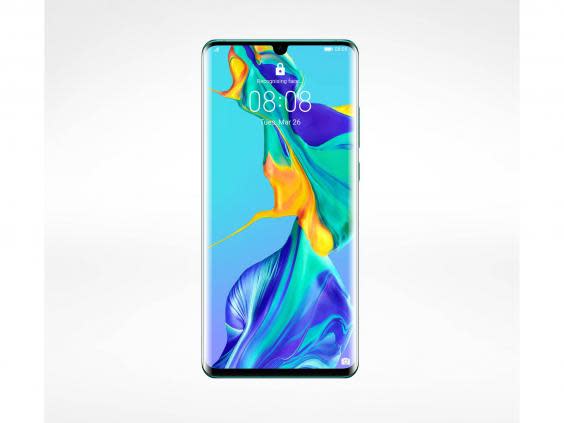
Screen size and resolution: 6.47in, 1080 x 2340 pixels, 398ppi
Screen technology: OLED
Storage capacity: 128/256/512GB
Expandable storage? Yes
Camera (rear): 40MP, 20MP, 8MP
Camera (front): 32MP
Dimensions: 158 x 73.4 x 8.4mm
Weight: 192g
Headphone jack? No
The P30 Pro is an outstanding camera phone. All the cameras are designed in conjunction with Leica and offer amazing versatility. As the focal length of each sensor is set, the phone switches seamlessly between lenses as you zoom in and out. There’s the main lens, a 5x telephoto and a super-wide lens. A fourth camera, called time-of-flight, helps to measure depth to maximise sharpness on the pictures you take. Beyond the cameras, the P30 Pro has a long-lasting battery and fingerprint sensor under the display. It also has two-way wireless charging so you can help a friend with a low battery if they have wireless charging capability. Huawei has recently had issues with the US but recent interventions by the president suggest that the situation has calmed. Huawei has also said that recent phones like the P30 Pro will definitely get the next major update from Amazon.
Sony Xperia 1: £849.99, Carphone Warehouse
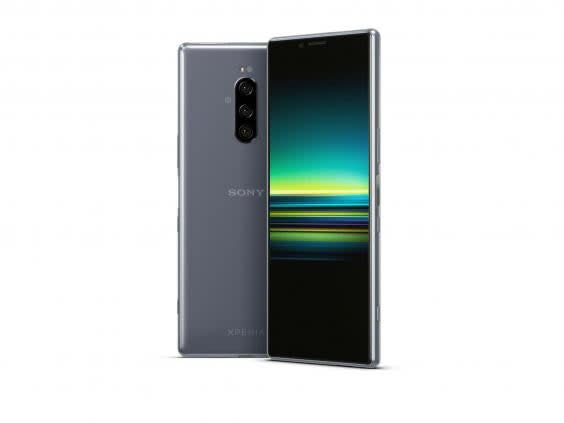
Screen size and resolution: 6.5in, 1644 x 3840 pixels, 643ppi
Screen technology: OLED
Storage capacity: 64/128GB
Expandable storage? Yes
Camera (rear): 12MP, 12MP, 12MP
Camera (front): 8MP
Dimensions: 167 x 72 x 8.2mm
Weight: 178g
Headphone jack? No
This is Sony’s first phone with three cameras. All are 12MP resolution but have different focal lengths to provide a telephoto lens with the equivalent of 2x optical zoom of the main one, and a wide-angle lens that’s 0.6x the main camera. The display on this phone is very eye-catching – it has 4K resolution, the same as a UHD full-size TV. Add to this the fact that it’s an OLED screen devised in conjunction with Sony’s TV division, and includes HDR capabilities and it means watching movies or shows on this screen is pretty eye-popping. The phone is longer and narrower than many, which may not suit everyone. It also lacks wireless charging – Sony says it wanted the slimmest phone it could make. Strong battery life, and a stunning display.
Huawei Mate 20 Pro: £799, Carphone Warehouse
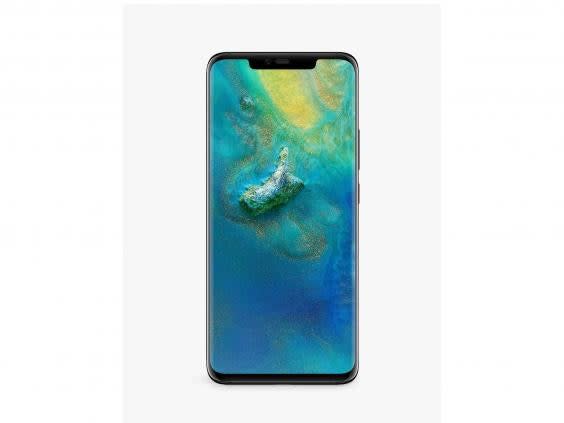
Screen size and resolution: 6.39in, 1440 x 3120 pixels, 538ppi
Screen technology: OLED
Storage capacity: 128GB/256GB
Expandable storage? Yes
Camera (rear): 40MP wide-angle, 8MP telephoto, 20MP ultra-wide
Camera (front): 24MP
Dimensions: 157 x 72.3 x 8.6mm
Weight: 189g
Headphone jack? No
Like the Samsung Galaxy S10+, this has two brilliant innovations, a fingerprint scanner in the screen itself and two-way wireless charging so you can recharge a friend’s phone. The triple rear cameras, all made in conjunction with Leica, are amazing, matching sharpness with detail and rich colours. The camera is very fast and takes reliably good shots. Huawei has built artificial intelligence into the camera to adjust images according to the subject (a cat will have more detail in the fur but a picture of a dog will enhance its eyes). The design is very eye-catching and the phone feels good in the hand.
Samsung Galaxy Note9: from £849, Samsung
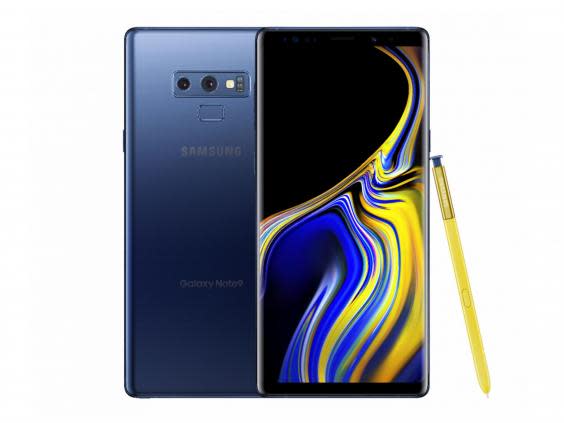
Screen size and resolution: 6.4in, 1440 x 2960 pixels, 516ppi
Screen technology: OLED
Storage capacity: 128GB/512GB
Expandable storage? Yes
Camera (rear): 12MP wide-angle, 12MP telephoto
Camera (front): 8MP
Dimensions: 161.9 x 76.4 x 8.8mm
Weight: 201g
Headphone jack? Yes
Samsung is one of the few companies that builds a traditional headphone jack into its flagship phones – and there’s no notch on the display either. The Note9 is so named because it has a stylus, called the S Pen, which pops out of the base of the handset and is used for scribbling notes on the large display, for instance. The latest S Pen also works as a wireless trigger: press the button and it’ll shoot a photo on the phone’s camera or advance your presentation to the next slide.
The screen is big but so is the battery – the biggest ever in a Samsung phone – and it lasts a full day with ease. This is also a phone with a very polished design. Because Samsung adds its own look to the Android operating system, it can take longer for the latest updates to arrive, compared to a phone from Nokia or Google, for instance.
Oppo Reno 10x: £699.99, Carphone Warehouse
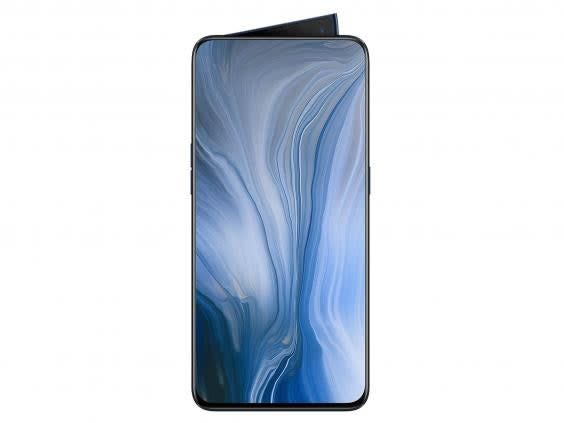
Screen size and resolution: 6.6in, 1080 x 2340 pixels, 387ppi
Screen technology: OLED
Storage capacity: 128/256GB
Expandable storage? Yes
Camera (rear): 48MP, 13MP, 8MP
Camera (front): 16MP
Dimensions: 162 x 77.2 x 9.3mm
Weight: 210g
Headphone jack? No
The Oppo Reno 10x has an all-screen front, a trick it carries off by burying the selfie camera inside the phone itself, like on the OnePlus 7 Pro below. But here the camera swings out in a shark-fin extension that looks great. As does the large display which is pin-sharp and colourful. On the back are three cameras including one with a focal length five times the regular lens. Because of optical image stabilisation and clever software, it means the camera delivers really excellent 10x zoom images. The camera software is not as advanced as on the Huawei P30 Pro, which remains the outstanding camera phone.
OnePlus 7 Pro: From £649, OnePlus
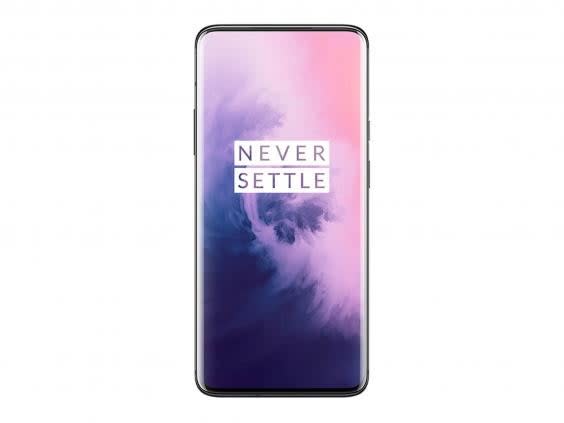
Screen size and resolution: 6.67in, 1440 x 3120 pixels, 516ppi
Screen technology: OLED
Storage capacity: 128/256GB
Expandable storage? No
Camera (rear): 48MP, 16MP, 8MP
Camera (front): 16MP
Dimensions: 162.6 x 75 x 8.8mm
Weight: 206g
Headphone jack? No
To make this phone as near to all-screen on the front as possible, OnePlus has hidden the front-facing camera. It pops up on a motorised mechanism from within the body of the phone when you need to use the face recognition to unlock the handset or take a selfie. It also has a fingerprint sensor, buried under the display. The three rear cameras are definite improvements on the previous (and already good) OnePlus cameras. There’s no wireless charging but it comes with a fast charger so you can charge the phone from pancake-flat to 50 per cent in less than half an hour. There’s also a 5G version of this phone which is almost identical to look at. That’s available on EE, on contract only.
Motorola One: £269, Motorola
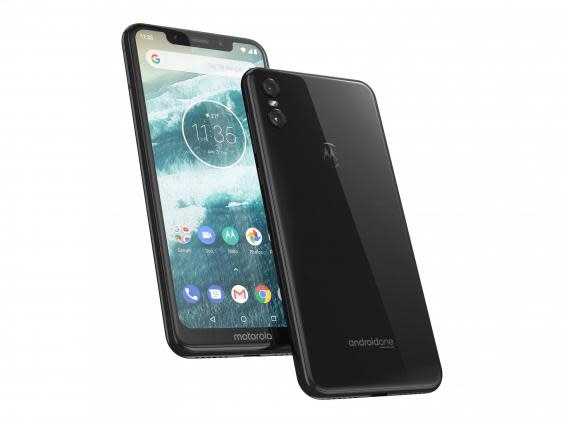
Screen size and resolution: 5.9in, 720 x 1520 pixels, 287ppi
Screen technology: LCD
Storage capacity: 64GB
Expandable storage? Yes
Camera (rear): 13MP, 2MP depth sensor
Camera (front): 13MP
Dimensions: 150 x 72 x 7.97mm
Weight: 162g
Headphone jack? Yes
This is a great budget phone, squeezing in a nearly all-screen display and dual cameras for a much lower price than you might imagine. And if you like the look of the iPhone XS, this isn’t dissimilar, and hides the fact that the screen doesn’t reach all the way down by putting the Moto logo there. It uses Android One, a platform which, because it uses a very plain version of the Android operating system, guarantees speedy updates for at least two years.
Twin rear cameras work using a medium-resolution sensor with a lower-resolution second sensor just used for depth sensing, to improve sharpness in low light and elegant bokeh effects. This is a fun and enjoyable phone to use.
BlackBerry Key2: from £469, Blackberry
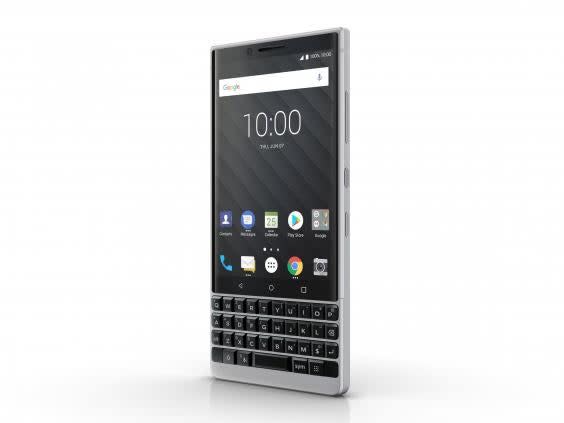
Screen size and resolution: 4.5in, 1080 x 1620 pixels, 434ppi
Screen technology: LCD
Storage capacity: 64/128GB
Expandable storage? Yes
Camera (rear): 12MP
Camera (front): 8MP
Dimensions: 151.4 x 71.8 x 8.5mm
Weight: 168g
Headphone jack? Yes
If you like to text on a physical keyboard instead of a glass screen, the BlackBerry is ideal. The screen is the smallest here, though still big enough for watching video, if not, an epic movie. The keys themselves are comfortable and make typing at speed a reality. They are also smart keys and you can “swipe” letters or words on to the screen. And there’s an extra secret, as the space bar is also the fingerprint sensor.
A special key lets you move quickly between apps, which is useful and quickly becomes second nature. And BlackBerry is known for its high-security options that sit on top of the Android operating system. The cameras are good enough, though outshone by others here. Battery life has always been key to BlackBerry and is decent in the Key2.
Nokia 7.1: £299, Carphone Warehouse
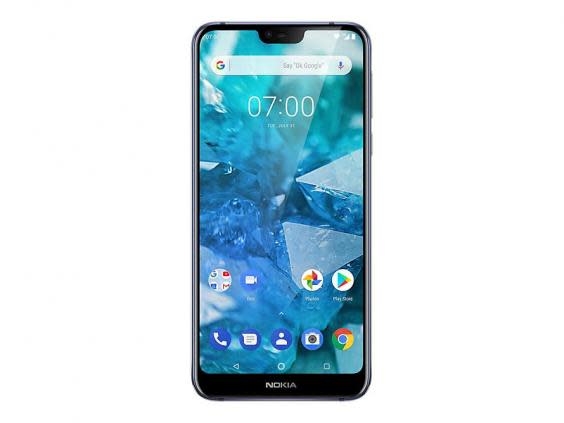
Screen size and resolution: 5.8in, 1020 x 2280, 432ppi
Screen technology: LCD
Storage capacity: 32GB
Expandable storage? Yes
Camera (rear): 12MP, 5MP depth sensor
Camera (front): 8MP
Dimensions: 149.7 x 71.2 x 8mm
Weight: 160g
Headphone jack? Yes
Nokia phones are now made by HMD Global, a Finnish company which has the licence to use the name and has much in common with the previous Nokia, including continuity of many designers and engineers. That’s evident in the stylish design here, the phone feels solid and appealing. Nokia has had an association with lens company Zeiss for years and that continues with this model – the camera is highly capable. Nokia uses a very plain version of Android (apart from the camera, the apps are all standard Google), which means Android updates come quickly. Nokia phones have outstanding build quality and this is no exception.
Google Pixel 3 XL: from £869, Google
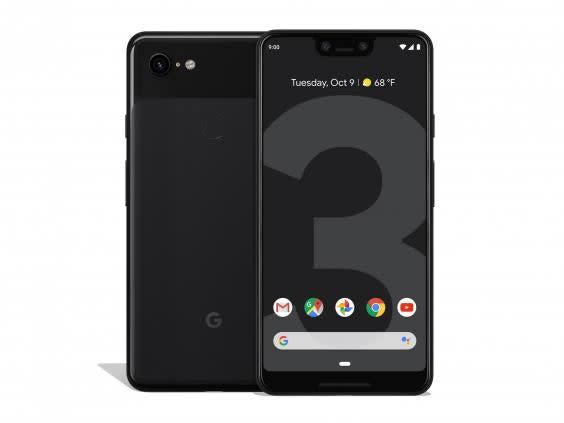
Screen size and resolution: 6.3in, 1440 x 2960, 523ppi
Screen technology: OLED
Storage capacity: 64/128GB
Expandable storage? No
Camera (rear): 12.2MP
Camera (front): 8MP
Dimensions: 158 x 76.7 x 7.9mm
Weight: 184g
Headphone jack? No
Pixels are the only Android phones where software and hardware are made by the same company. The new Pixel 3 comes in an XL and a smaller regular size. The XL has a notch at the top of the screen, and it’s a slightly weird looking one at that, but the smaller phone does not. Google has eschewed the dual camera system favoured by many, making effects like bokeh happen entirely through software.
This may sound like a poor solution, but in fact it works extremely well and like other phones here, Google uses AI to improve exposures and other details for better results. It performs especially well in low light thanks to a Night Sight feature – though the Huawei P20 Pro is also very proficient in near-dark situations. It also uses AI as a system to screen calls automatically, the company claims. Google’s own-brand phones always have the very latest software first, which is useful.
The verdict: Smartphones
Apple’s iPhone 11 Pro is tremendous, with astonishingly good cameras and, just as important, significantly improved battery life. For many, the much-cheaper Apple iPhone 11 will satisfy the most demanding expectations. The Huawei P30 Pro has a fingerprint sensor under the display and an astonishing camera set-up that’s better than everything else here – though the iPhone Pro camera has a new feature called Deep Fusion coming this autumn that may put it in the lead again.
Read more
Best iPhone 11 and 11 Pro cases that protect your new device
10 best laptop bags and cases to protect your precious tech
11 best iPhone X and XS cases to protect your most prized possession
10 best Samsung Galaxy S10, S10+ and S10e cases

 Yahoo Finance
Yahoo Finance 